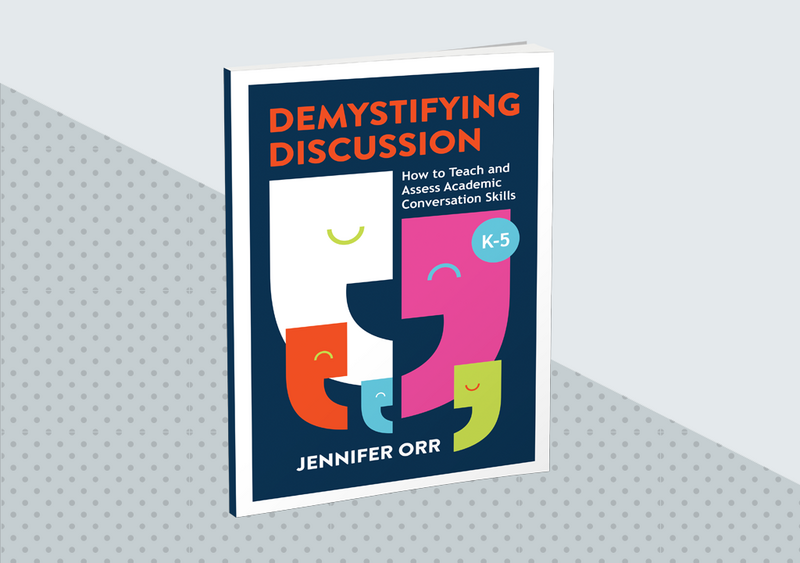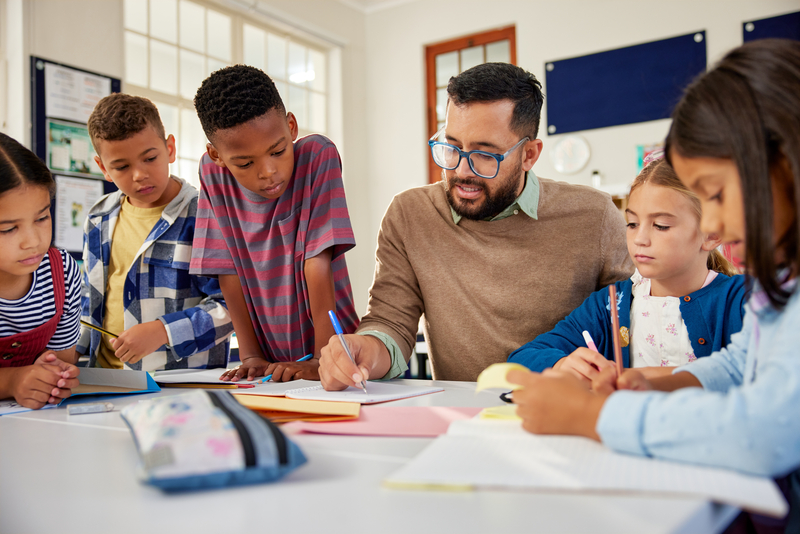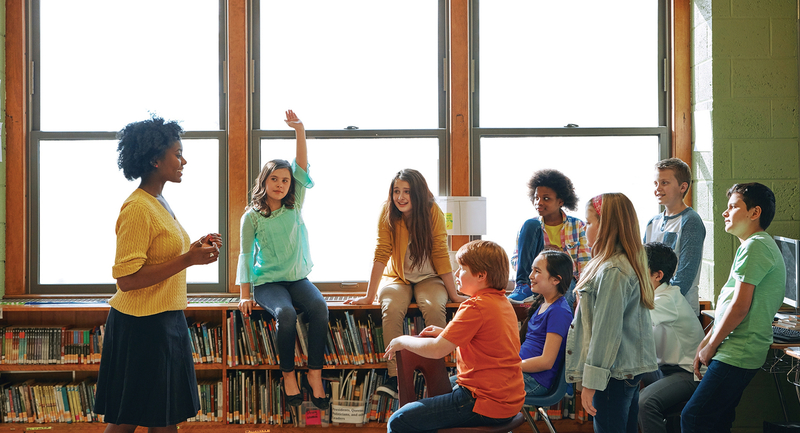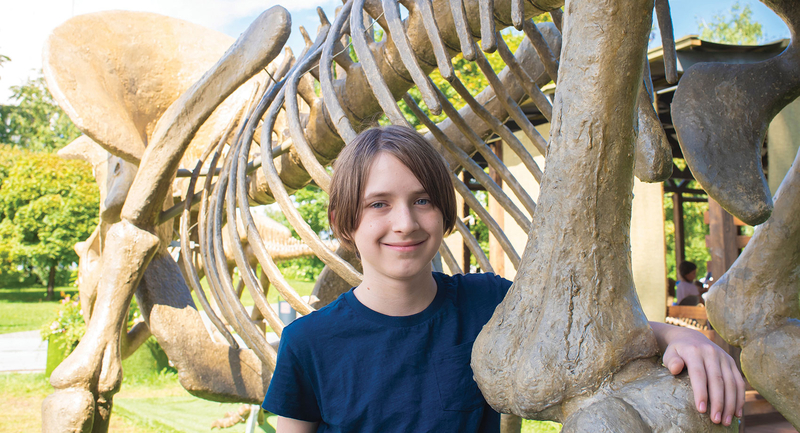When I was teaching kindergartners, one of my students asked, "If Earth is always turning like you say it is, why don't we feel it?" It was a great question, but one that caught me off guard. And because we were headed to lunch in just a few minutes, I couldn't engage the class in an in-depth discussion of her question at that time, though it was something I wanted to address.
I may not have been prepared to answer her, but her classmates definitely had thoughts. Some were quick to second her question, with a look on their faces that suggested I had been misleading them when it came to Earth's rotation. Others had immediate theories they began to share. As I got my thoughts together, I asked the original student if we could write her question down on the board so that we would remember it and come back to it later. She agreed and we got ready to head to lunch. On our way and throughout lunch, the conversation about her question continued—and I could see how my students were using their critical thinking skills.
Young students ask many questions and talk quite a bit. Talking and listening are huge pieces of how young people learn, and the ways children interact with others—conversations being just one example—impact their thinking and development. This is clear when you hear a child repeat things they've heard others in their life say, even if not always completely accurately. It can also be seen when children ask questions about things they hear from others. Theorists Jean Piaget and Lev Vygotsky argued that learning is a social activity and "emphasized the close connection between the development of the child and the forms of interaction between the child and adults, as well as with other children" (Rubtsov, 2020).
With a few thoughtful prompts and a lot of noticing and modeling, we as educators can help young students engage in academic conversations in ways that deepen their learning.
As an educator in Virginia, I am frequently focused on the "5Cs" that our state's Department of Education has identified as important to helping our students develop the skills they need to be successful: critical thinking, collaboration, communication, creative thinking, and citizenship. Classroom conversations address all five of these Cs, though in this article I'd like to focus on their effects on critical thinking. As my kindergartener asking about Earth's rotation illustrates, an interesting question and the discussion that follows can open up paths of critical thinking for students at any age. With a few thoughtful prompts and a lot of noticing and modeling, we as educators can help young students engage in these types of academic conversations in ways that deepen their learning and develop their critical thinking skills.
Critiquing Our Thinking
What does critical thinking mean? This phrase is used frequently in education, yet rarely defined. It is difficult to teach and support students in developing a skill if we do not understand what it is. Linda Elder and Richard Paul (2008), who have done extensive work on critical thinking, write:
Good thinking is thinking that (effectively) assesses itself. As a critical thinker, I do not simply state the problem; I assess the clarity of my own statement. I do not simply gather information; I check it for its relevance and significance. I do not simply form an interpretation; I check to make sure my interpretation has adequate evidentiary support.
For young children, this is a serious challenge. (Honestly, it can be a challenge for many adults as well!) Critiquing our own thinking, questioning what we believe, backing up our ideas, and even changing our mind and revising our thinking, all take time to develop. Helping students begin to build these skills when they are young is essential. As cognitive scientist Tim van Gelder (2005) wrote, "Critical thinking is more of a lifelong journey than something picked up in a two-week module. However, just because mastery takes such a long time, it is never too early—or too late—to start working on it." Our early elementary students can definitely begin the work—but we must remember that it will be work, for them and for us. Conversations, especially about academic content, are a natural way for students to practice thinking critically.
The Power of a Good Prompt
One way to direct classroom conversations to encourage critical thinking is to make sure you are setting students up with strong prompts or questions. Whether students will be talking with one partner, in a small group, or as a whole class, the question or prompt you present to them must engage their interest, pique their curiosity, and pull them into the discussion. Questions should be open-ended—having one right answer will make for a dead-end conversation pretty quickly—with an intriguing introduction or a provoking idea to really dig into.
When considering prompts to use, here are several general ideas that can be useful:
1. Low floor, high ceiling. Prompts that have a low floor (are easy to get into and possible for all students to respond in some way) and a high ceiling (can be discussed at fairly high levels of complexity) are optimal. A "Which One Doesn't Belong?" prompt, such as Christopher Danielson illustrates in his book by the same name (Stenhouse, 2016), is a great example (see fig. 1). Students can look at four images, such as different types of pyramids, and justify why one of them does not belong with the others.
As you can see in Figure 1, which features photos I took on a recent trip to Egypt, there are obvious reasons why any of the images would not belong (one is food, one has steps, one has the sphinx, etc.). That's the low floor that is open for all students to enter. However, conversations can quickly go beyond that low floor to become more complex and interesting. In a recent conversation about these images, for example, my 3rd graders noted the differences in the tops of the pyramids and hypothesized about the building materials used in each one. They began with the obvious ideas about the rice or the pyramid with the sphinx not belonging, but then began thinking more critically and creatively. In the discussion that resulted from these pictures, students agreed and disagreed with one another, listening closely to their classmates, considering what they were hearing, and adding their thoughts. It pushed them to take their critical thinking to another level, analyzing their ideas with others.
2. Engage students' perspectives. Choose a prompt that puts your students into the question. For example, at the end of our ladybug unit, I often ask my 3rd graders, "What are four living and four nonliving things you would need and want if you were designing your own ecosystem?" That question pushes them to think about what makes up an ecosystem, but it makes it personal by asking them to create their own. Similarly, during our studies of ancient civilizations, I might ask, "Would you want to have lived in ancient China, and why do you feel that way?" Or, "Would you have rather lived in ancient China or ancient Mali and why?" By centering my students in the question, they will often think more deeply about their answer. They will also, often, jump into a conversation with a partner or group with energy because their answer is about themselves.
3. Let them argue. Showing 1st graders a square and telling them that it is a rectangle really gets them talking! If we give students prompts that allow them to argue for or against something, they will naturally become engaged.
For example, in our fractions unit in 3rd grade, I show my students a square cut into fourths with two unconnected sections shaded and ask if the two shaded sections equal ½. Students quickly have thoughts and share them. As they talk and listen to one another, students consider their prior knowledge of fractions and how this example does and does not fit into it. Students often start with statements like, "That is not ½ because there are four parts." As students agree and add their thoughts, one student will typically join in with disagreement. This shift in the conversation often stops everyone briefly, but results in lots of questions and elaborations on thinking. Not every student walks away able to accept that the image shows ½, but they do all walk away with a wider set of ideas and more to consider and build on in the future.
You can also encourage students to push their thinking by offering a question or idea that seems obvious, but not in the same way to everyone. Place two boxes of different shapes, such as a long, rectangular one and a fatter, cube-like one, in front of students. Ask them which box is larger. Many students will immediately have an opinion and some reasoning as to why. As they listen to one another, they begin to view the boxes differently. They might realize, for example, they were thinking of bigger as meaning taller while a classmate was thinking of bigger as meaning holding more. You can watch students flip back and forth in their thinking. They are thinking more flexibly based on what they are hearing.
Naming and Noticing
Another tactic to use to build critical thinking in young students is to notice and name when they do it. Even our youngest students arrive in our classrooms with some conversational and critical thinking skills. They talk with family members, peers at Sunday school, friends at the park, and more. These students have had to make choices and think through options, and they've begun developing themselves as critical thinkers. Students will, of course, vary in the strength and breadth of all these skills, but identifying them and building on them as their teacher will move them forward as conversationalists and thinkers more quickly.
Too often, in school, we focus on the things our students are not yet able to do, rather than recognizing their current abilities and using those to push them forward.
Too often, in school, we focus on the things our students are not yet able to do, the bars and benchmarks they have not yet met, rather than recognizing their current abilities and using those to push them forward. It requires a mental shift for us, as teachers, to use this lens when we see our students and to plan from this perspective. However, once we work on that shift, it is surprisingly easy to use students' strengths as a place to begin and to build from.
One way to do this is to notice and name positive things students are doing, both in their conversation skills and in the thinking they are demonstrating. To do this, you must have some idea of your end goal—what it is you want your students to be doing as conversationalists and thinkers.
At the start of each year, one of my first goals for my young learners is that they actively listen to their peers. I can tell that my students are doing that when they make eye contact and nod along with whoever is talking. When they respond to a classmate by saying, "I agree with you because . . ." or "I disagree because …," or they ask questions or paraphrase what a classmate has said, they demonstrate that they are listening. I make sure to notice and name these behaviors to reinforce listening skills. After a conversation, or even in the midst of it, I might say, "I noticed Amelia was listening to Elise because she asked her a question about something she had heard her say."
Through noticing and naming, the student who demonstrated the skill receives reinforcement. Their peers also get the opportunity to see the skill modeled, organically, for them by a classmate. It is a significant payoff for a very easy action for me as the teacher. For many years, I have created a notice and name board in our classroom, where I display sentence strips with skills I am helping my students gain. I add sticky notes when I notice students modeling that skill (see fig. 2). Some years, students ask me to add a sticky note for their fellow classmates when they notice them demonstrating listening skills.
Noticing and naming can be done for thinking skills as well. One of the most common things I notice and name is when students revise their thinking. For example, "I noticed that Bentley started by saying that he thought the character in the book was being unkind, but throughout the conversation he revised his thinking and decided that the character was facing challenges and responding as best he could."
I deliberately use the word "revise," rather than "changing their mind," because revision is also something I encourage students to do as writers, and I want them to see revising their thinking as a growth process and not as something they do because they were wrong. Revising doesn't mean we were previously wrong. It means we have grown and have a more solid understanding.
In classroom conversations, students frequently revise their thinking. Honestly, so do I! Noticing and naming this helps students to recognize the positive outcomes from revising thinking as well as what it looks like to do so.
Conversations and Critical Thinking: A Power Duo!
Critical thinking is a skill our young students will need throughout their lives. While there are a wide variety of ways to help students grow as critical thinkers, conversations offer several benefits. To make conversations work as a powerful learning tool, we cannot just expect students to discuss content and ideas without support from us. Offering them thought-provoking prompts and questions is one vital step. Noticing and naming their strengths as conversationalists and critical thinkers is another. Fostering investigative conversation among young students is not an easy process, for our students or for us, but the ability to think critically about ideas and the world around us is a worthy goal we should be working toward for our students.
Reflect & Discuss
➛ Do the prompts and questions you use with students meet Orr’s guidelines for encouraging critical thinking?
➛ How do you actively notice and incorporate students’ prior knowledge into your teaching?
➛ Why is it so important for our youngest learners to develop critical thinking skills?
Demystifying Discussion
Jennifer Orr offers elementary school educators strategies for teaching K-5 learners to engage in student-led academic conversations.










